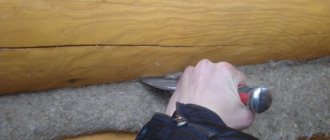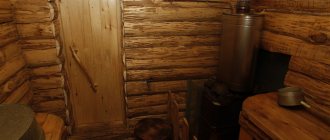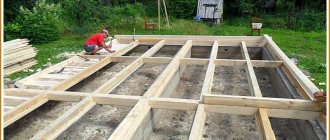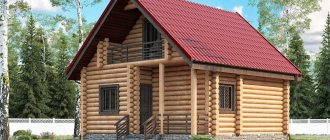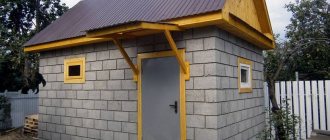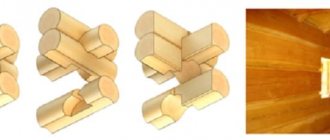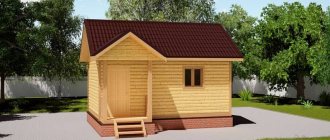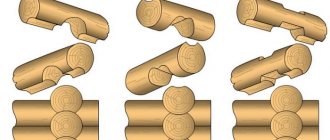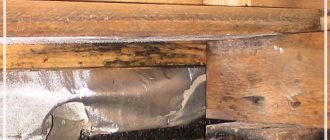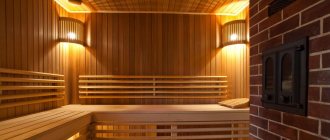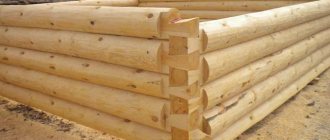How to permanently repair a crack in a timber or log.
Cracks inside wood can occur for various reasons. Sometimes they appear due to excess stress inside the wood, seasonal shrinkage, mechanical damage or other reasons. In order to eliminate them, you will need to use a wide arsenal of products - sealants, putties, adhesives and other products that are aimed at different types of defects. This article will discuss the best technologies and materials that are used to repair cracks in logs and beams - we are talking about large longitudinal cracks and small chips.
Wooden house projects
Number of projects 1654
- 4 rooms
- 2 bathrooms
House Project Tura-1B
- To favorites
- 116.1² Total area
- 11 x 8m Construction area
from 1,803,000 rub.
Construction period 55 days
- 5 rooms
- 2 bathrooms
Project of the Chekh-M2 House (with combustion chamber)
- To favorites
- 106² Total area
- 8 x 8m Construction area
from 1,431,000 rub.
Construction period 58 days
- 4 rooms
- 2 bathrooms
Champion House Project
- To favorites
- 103² Total area
- 7 x 8m Construction area
from RUR 1,075,166
Construction time individually
- 1 room
- 1 bathroom
House Project HPL-0020-N00xx-0028
- To favorites
- 28² Total area
from 560,000 rub.
Construction time individually
- 4 rooms
- 4 bathrooms
Project Summer Guest House “Quartet”
- To favorites
- 108² Total area
- 6 x 9m Construction area
from 833,000 rub.
Construction time individually
- 4 rooms
- 1 bathroom
Project AS-267-2
- To favorites
- 134.4² Total area
from 1,814,400 rub.
Construction time individually
- 4 rooms
- 2 bathrooms
Country House Project
- To favorites
- 196² Total area
- 11 x 12m Construction area
from 2,646,000 rub.
Construction period 98 days
- 4 rooms
- 2 bathrooms
Rainbow House Project 9.5x10.5
- To favorites
- 150² Total area
- 10 x 11m Construction area
from 2,025,000 rub.
Construction period 78 days
- 5 rooms
- 2 bathrooms
Terem House Project
- To favorites
- 137.4² Total area
- 11 x 7m Construction area
from 1,957,000 rub.
Construction time individually
- 2 rooms
Mushroom House Project
- To favorites
- 61² Total area
- 6 x 6m Construction area
from 437,167 rub.
Construction time individually
- 4 rooms
- 2 bathrooms
Project of the Pechora-2B House
- To favorites
- 82.5² Total area
- 6 x 9m Construction area
from 851,000 rub.
Construction time 33 days
- 6 rooms
- 2 bathrooms
House Project No. 14081-FK
- To favorites
- 203² Total area
- 14 x 12m Construction area
from 7,137,468 rub.
Construction time individually
- 6 rooms
- 3 bathrooms
Log House Project DO-033
- To favorites
- 358² Total area
- 13 x 15m Construction area
from 4,833,000 rub.
Construction period 90 days
- 4 rooms
- 1 bathroom
Camelot House Project 7.5x7.5
- To favorites
- 87² Total area
- 8 x 8m Construction area
from 1,174,500 rub.
Construction period 49 days
- 5 rooms
- 1 bathroom
Camellia House Project
- To favorites
- 140² Total area
- 8 x 15m Construction area
from 1,890,000 rub.
Construction time 73 days
- 2 rooms
- 1 bathroom
House Project No. 12014
- To favorites
- 83² Total area
- 9 x 5m Construction area
from RUR 1,983,396
Construction time individually
- 5 rooms
- 2 bathrooms
Anapa House Project
- To favorites
- 122.3² Total area
- 9 x 9m Construction area
from 1,430,000 rub.
Construction time individually
- 6 rooms
- 3 bathrooms
House Project MPC-1816-F0155-0337
- To favorites
- 385² Total area
from 6,774,000 rub.
Construction time individually
- 1 room
- 1 bathroom
Log house project Pavel
- To favorites
- 65² Total area
- 6 x 4m Construction area
from 215,000 rub.
Construction time individually
Available at the exhibition
- 5 rooms
- 2 bathrooms
House Project C160
- To favorites
- 190² Total area
- 8 x 10m Construction area
from 3,270,000 rub.
Construction period 60 days
View all projects
Wood is used to build houses and baths because the material breathes, is safe for health and retains heat well. Destruction of the structure leads to the appearance of cold bridges, destruction and biological damage. Let's consider how to repair cracks in timber indoors or outdoors to prevent the negative consequences of splits.
Splitting a tree Source vocesdelasierra.org
Prevention of cracks
Wood is a material on which moisture has a destructive effect. The array is also breathable. When temperature changes with humidity, it becomes deformed.
The high density of the fibers does not allow the log to dry completely. The process occurs from the surface cover to the center, but the core remains moistened for a long time. As a result, the outer and inner layers have different resistance to mechanical stress: wet ones are more resistant, while dry ones become brittle. Therefore the tree bursts.
The likelihood of cracks appearing is affected by the period in which the cut was made. In summer, sap exchange occurs more intensely, which explains the high level of natural moisture in the material. Therefore, it is recommended to harvest timber in winter for the construction of houses.
Logging Source mainavi.ru
Preventive measures
Freshly cut timber cannot be used to build houses. The material must be dry so that when shrinking the walls do not become covered with cracks. In addition to reducing humidity, production lines carry out screening according to regulations, which are prescribed in state standard 2140-81. According to the rules, defects include the following:
- knots and cracks;
- curvature of the trunk shape and texture;
- damage by fungus, mold, bacteria and insects;
- foreign inclusions and chemical damage;
- deformation from mechanical stress.
Drying is carried out naturally. This ensures coolness, low relative humidity and shade. It takes at least two years to prepare wood for felling. Then the width of the cracks that will appear one way or another will be 1-2 mm. For comparison: on a one-year-old log, voids 6-10 mm wide will appear, and on a more recent log - 10-20 mm.
Also, before use, the material must undergo primary treatment with an antiseptic composition, a fire retardant and against bacteria and insects. After this, the tree is also dried.
Drying logs in production Source www.lestrade.ru
In order to avoid having to decide in the future how to repair cracks in the logs of a wooden house, the planners often make a compensatory longitudinal cut. It is otherwise called unloading. Its width is 8-10 mm, and its depth is ⅙ or ⅓ of the diameter of the log. The groove is formed by a chainsaw, machine, disk or router. It promotes uniform drying of the wood and speeds up this process. When assembling the log house, the cut is directed upward and covered with the next sheet.
However, not all experts agree with this preventive method. They explain this by the unpredictability of the behavior of the forest after 10 years of operation. Previously, wood was used after two years of aging without cuts or cuts.
Video description
A little about the cuts and protective measures is described in the video:
See also: Catalog of projects of houses made of timber with two entrances for a family.
Why do you need to seal cracks?
Any split is a place for water to penetrate into the flesh of the log. The core cannot quickly release moisture, which increases the likelihood of rotting. This is where bacteria grow, fungus and mold appear. Bark beetles also like to live in cracks and destroy any tree. Among other things, heat escapes through these places. All this can be prevented only by sealing the damaged areas.
Consequences of the bark beetle's activity Source pbs.twimg.com
Acrylic putty for wood
This is sold in construction stores, although it is easier to find it where consumables for carpentry are sold. It is important to consider that it is almost pointless to try to seal wide cracks with putty. If the defect is more than 3-4 mm, it is better to use some other material. Otherwise, the putty will crack over time and begin to fall out of the cracks.
The embedding technology is similar. First, the cracks are sealed with a spatula, then the timber is sanded, painted, varnished, and so on.
Methods for sealing cracks: pros and cons
Protecting wood involves preventing water from penetrating into the cavity of the wood. Therefore, the materials used must ensure tightness and adhere well to cracks. Options that will be resistant to operating conditions are also being considered.
Regardless of the material chosen, it is important to prepare the base. It should be dry, free of dust and nicks. Affected areas and damage must be repaired.
A mixture of sawdust and PVA
How to repair cracks in timber outside a house - the answer lies in materials that are resistant to environmental conditions. You can use moisture-resistant PVA glue and sawdust. The shavings are not suitable for the event, as they are large. A homogeneous mass is applied with a spatula. Since the product shrinks after drying, the seal is repeated. It is recommended to treat only minor damage.
Sawdust with PVA Source sbly-web-prod-shareably.netdna-ssl.com
In addition to PVA, it is permissible to use wood glue with a different composition. This will not affect the permissible width and depth of the split, but will have a positive effect on strength, moisture resistance and durability. High adhesion is also ensured. To minimize shrinkage, experts often use wood dust instead of sawdust. The composition is applied in excess; after drying, the excess is cut off and sanded with fine abrasive.
See also: Catalog of companies that specialize in the construction of garden houses and the manufacture of garden furniture.
Slivers
Before sealing the cracks in a wooden house with wood chips, you need to sharpen them with a wedge in cross section. The blanks are driven into a split of any width along the entire length. Additionally, to ensure strength and reliability, the cavity is treated with moisture-resistant PVA. If the damage is significant, then a mixture of sawdust and glue is used.
In order to prevent further expansion of the split, butterfly dowels can be installed. These are inserts shaped like an hourglass. This will ensure stabilization of the base. The parts usually have a thickness of 10-15 mm; they are inserted into the prepared groove along with glue.
Butterfly dowels Source www.peredelka.tv
Tyrsa
This material often means a mixture of sawdust and sand. In fact, this is fine-grained crumbly waste after cutting more than two types of limestone. The mass may contain up to 10% clay, which makes the material moisture resistant. The mass hardens quickly and has vapor permeability and high strength.
Wood putty
The requirements for how to repair cracks in timber inside a house are more specific than for the façade. Putty is often made on the basis of acrylic resins. The material can be applied in a layer of up to 3 mm, so it can only be used to treat minor cracks. Exceeding the norm contributes to cracking of the dry residue. Also, shrinkage of the solution can lead to its peeling off from the base.
According to its characteristics, the ready-to-use mass has plasticity. The material can be presented in two forms:
- One-component has one binder. It can be water, alkyd or acrylic resin. The product is ready for use after mixing the paste.
- Two-component ones must first be prepared. They are represented by filler and hardener. They are characterized by rapid hardening (several minutes), increased strength and elasticity, minimal shrinkage, and inertness to moisture and solvents.
Wood putty Source remont-samomy.ru
Consequences of wood delamination
Small cracks are not capable of causing serious damage to the finished building. But deep defects and damage can cause uneven shrinkage of wood and deformation of the entire structure of the log house.
When eliminating defects, you should not ignore the smallest grooves and cracks, which, under the influence of high humidity, can become a breeding ground for mold, fungal formations and rot.
All this can lead to the destruction of the log house itself and a decrease in its performance characteristics.
Video description
The video shows how and what needs to be done to protect logs using putty and sawdust:
Acrylic sealant
Before sealing the cracks between the logs in a wooden house with sealant, you need to clean the base. A moisture-resistant elastic mass on an acrylic base can be applied in a layer of up to 5 mm. If the depth of the split is large, then a silicone cord or polymer cord is first immersed in it. They are not associated with the production environment, so the placeholder's behavior will not be changed.
Wood sealant Source massivcolor.ru
Experts have differing opinions regarding sealant. The cork practically does not breathe; the mass penetrates into the pores. This leads to a decrease in the ability of the log to release moisture in the damaged area. That is, the risk of rotting and subsequent biological damage increases.
There is a possibility of dust formation under the sealant film. This will cause the aggregate to fall out and cause the split to increase in width. Silicone or polymer cord can affect the creation of a greenhouse effect, which also results in mold, mildew, bacteria and rot.
Sealant
The sealant appeared on store shelves at the very beginning of the 90s. It came to us from the last century, but nevertheless, a better replacement has not yet been found for it. It is based on silicone. It is able to create a protective film on the surface that will be processed. It is valued for this unique property. It is clear that since the 90s the composition has been subject to changes, but not major ones. Now it has dyes and a couple of additional elements. The sealant is almost one hundred percent good, but it also has its pitfalls. The surface treated with it no longer allows air to pass through. Lack of oxygen, in turn, leads to gradual destruction of the material.
Traditional methods
How to seal the seams between the logs of a log house from the point of view of the grandfathers - the best solution is moss. Previously, gaps and splits were caulked. More often, a common plant was used as a material. If it was dry, then the moss was pre-soaked in water for 30 minutes and squeezed out before use. The mass must be rolled into rolls and pushed into the crack. In order to compact the aggregate, it is tapped using a caulking spatula and a hammer or mallet. It is important to achieve a spring-like result.
It takes about 72 hours for the moss to dry. During this time, the volume of material increases to 20-30%. As a result, the cracks are clogged, the filler breathes, and the excess is cut off using a petal circle.
Epoxy resin with sawdust
A little expensive method, but very effective. To prepare the repair mixture, epoxy resin and sawdust are taken. The proportion is twice as much sawdust as resin. The sawdust fraction plays an important role here. The smaller they are, the better. This method has several advantages. First, epoxy resin is very strong and durable when cured. Secondly, if you correctly guess the consistency when preparing the repair mortar, you will be able to repair even the most microscopic cracks.
